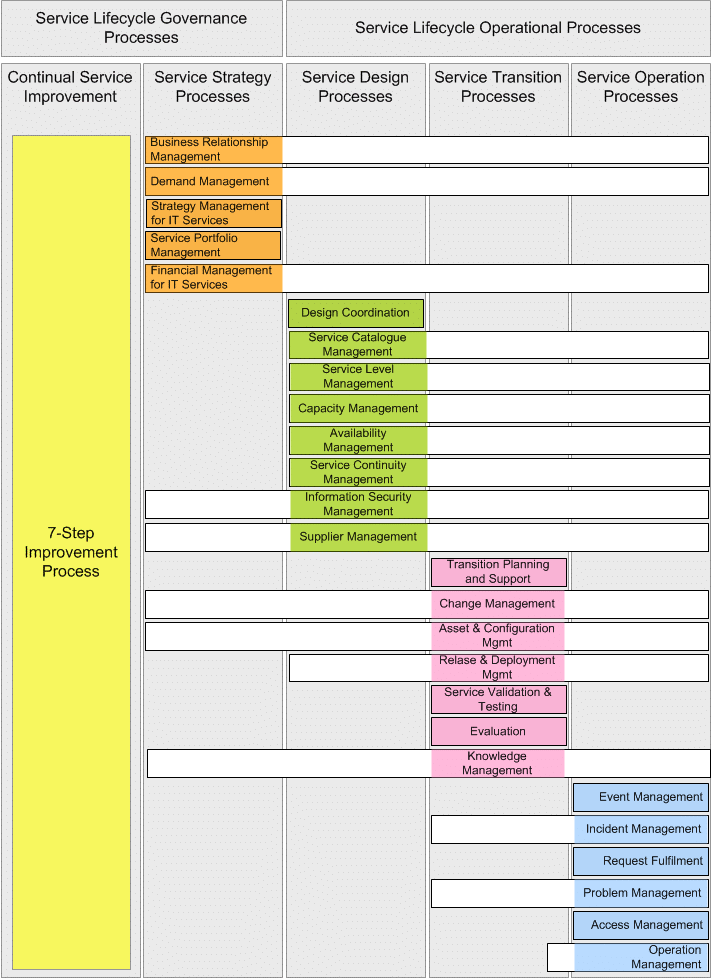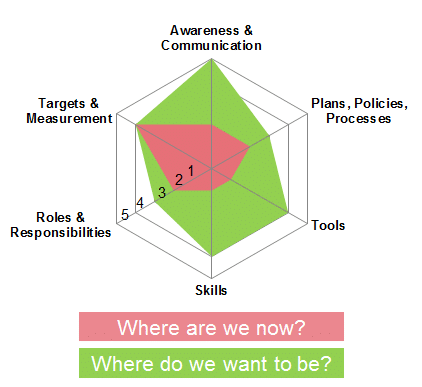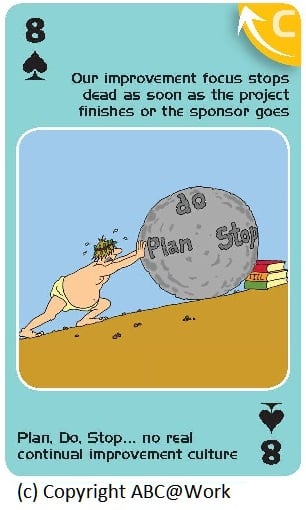Where do we start? How do we improve? How do we know that we are making progress? Many organizations are having difficulties in defining and driving their roadmap for IT Service Management (ITSM) forwards in an appropriate structured manner. Sure, at the end it’s all about optimizing efficiency, effectiveness and cost structure of services and underlying processes – but how do we get there?
The knowledge of the ideal world of processes as explained in the well-known best-practice frameworks offers only limited help, what is definitely missing is a planning and implementation approach, which translates your vision into right priorities and last but not least makes sure that it gets done. For me the answer to this is the CSI approach (formerly also known as CSI model). It is a simple but effective approach, which asks the right questions in the right order. Let me show you an easy example deliberately not related to IT and you will immediately understand the concept:
- Question 1: What is the vision?
Answer: I want to be a fast runner.
- Question 2: Where are you now?
Answer: I can run 10km in 60 minutes
- Question 3: Where do you want to be?
Answer: I want to be able to run 10km in 50 minutes
- Question 4: How do you get there?
Answer: I need to train 3 times a week
- Question 5: Did you get there?
Answer: I measure my progress each week
- Question 6: How do you keep the momentum going?
Answer: Even if I have reached my goal I have to continue to train. Eventually I have to revise my vision and set new goals.
This makes completely sense, isn’t it? Using the above approach brings some significant advantages:
- The vision is broken down into clearly measurable metrics and targets. Remember: You can’t manage what you can’t measure!
- Actions developed in step 4 have a clear rationale (they close the gap between 2+3) and progress is measurable.
- The vision is not something carved in stone, it is something that can change over time. The CSI approach takes this into account by continuously verifying the vision and if required redefines the targets and needed actions. This ensures also agility in what you are doing.
- Evolution instead revolution: By asking the question ‘where are we now?’ right after the vision is clear, the current situation is respected. This is often not taken into account, e.g. by using a pure top-down approach.
- The CSI approach is in itself methodically water-proof and simple to understand. This also leads to higher acceptance of all stakeholders. Don’t forget that missing acceptance and the resulting resistance to change is one of the main reasons of failure.
- The principle of continuous improvement is adapted by asking the question ‘how do I keep momentum” – no “plan, do, stop!”. Instead: ‘Plan, do, check, act’

Applying the CSI approach to IT Service Management
How do we adapt the CSI approach to IT Service Management? Conceptually there are still the same six CSI approach questions asked, but because IT Service Management is a complex system, the way to answer the question is not as straight-forward and easy as in the simple example above. We need to break down IT Service Management into manageable pieces. Let’s go through it step-by-step:
1) What is the Vision?
This step is about understanding the business objectives and aligning IT to the business. Here a proposal of some questions which will you help on this:
- What are the strategic goals of the IT for the next years? (main source: Business & IT Strategy)
- What is the expectation of the business?
- Current problems they have with IT? (note: perception vs facts)
- Which expectation is not met and why
- Strengths of IT from a Business perspective?
- Future trends? (e.g. seasonal or exceptional changes in demand which influence the needed IT Capacity)
- Restrictions (actually important to set realistic timelines for the actions in step 4):
- Ressources financial, budget
- Ressources FTE
2) Where are we now?
I will spend some time on this step because it prepares the ground for the next steps. The purpose of this step is to perform a baseline assessment to get an accurate snapshot of where your organization is right now. Without this you will not be able to define a gap with where you want to be and to define actions to get there. In the example I mentioned in the beginning of the article this was simple and straight-forward, however if we look at IT Service Management as a complex system this is not as easy anymore and there are two issues we need to address:
First, we need to breakdown the whole system into manageable pieces. Because you don’t want to reinvent the wheel, this is where best practice frameworks such as ITIL or Cobit are appropriate. For example you would ask the question ‘Where are we now?’ for all the 25 disciplines within ITIL, e.g. where are we now in regards to Demand Management, Service Level Management, Incident Management etc etc.

Secondly, you need to have a framework for a meaningful measurement of each discipline mentioned above. Even if you broke down your ITSM system into 25 pieces as mentioned above, it might be for example difficult for you to answer the question ‘Where are we now in regards to Incident Management?” How can I do that? Here I suggest to do a breakdown into different dimensions (this comes from COBIT) and make an assessment from 1-5:
- Awareness & Communication: Is there an awareness & understanding of the need to act and is there accordingly a communication happening? Rate from 1-5
- Tool Dimension: To which extent is the discipline supported by a tool. If you have no ITSM tool for Incident Management in place, the answer is 0, if you have it perfectly supported, integrated and managed, the answer is 5
- Policies, Processes & Plans: Do the same for this area
- Are there clear responsibilities&accountabilities defined for the area?
- Goal setting & measurement: Are the process goals set and regularly measured?
3) Where do we want to be?
In this step you set measureable goals against the as-is metrics out of step 2 (comparing apples by apples, important for step 5!) by agreeing and understanding the priorities for improvement. For this you need a deeper development of the vision in step 1. If for example operational stability is one of the key messages out of the vision, you need to have a deeper look at Change Management and higher maturity in some of its aspects. Below an example how this graphically could be represented along the 5 dimensions:

4) How do we get there?
This is the part were you define the long-term roadmap itself by developing actions. The goal is to close the gap between step 2 (Where are we now) and step 3 (Where do we want to be). On the one hand you need to set the right priorities (which actions should be done first) to support the vision and also take into account what you actually CAN do, given the financial and FTE (personell) ressources in step 1. This will finally enable you to put the actions on a timeline.
Just to put the pieces together in a practical example: If you found that stability is one of key messages in the vision (step 1) and the assessment in step 2 showed that there is a lack of change policies and approporiate control procedures the conclusion in step 3 (where do we want to be?) might be that you need to have a higher maturity in these areas. Translating this into actions (this step) means that a Change Policy has to be defined (“No change without formal RfC”) and existing Change Procedures to be reviewed and adapted. It makes sense to package these actions into reasonable groups and assign responsibilities and due dates behind. Together with all other action packages you defined this builds your ITSM roadmap.
5) Did we get there?

This is about classical progress tracking. Check contiuosly if milestones were achieved and business objectives and priorities were met by the level of service. Take corrective actions if due dates were missed.
6) How do we keep the momentum going?
This step is often missed but key to ensure that there is a long-term improvement. The cycle of 1-5 needs to be repeated over and over and it actually never ends. First, this is important to make sure that the vision is continuously verified and you align your action to a changing environment. Secondly, the organizations tends to fall back to the original state if there is no continuos omprovement culture and you have to start from the beginning again.
What’s next?
I hope you enjoyed my blog and it gave you some new ideas. Where to go from here? Maybe you have the need to improve your skills on this topic. Consider taking a ITIL Expert training, which has also a focus on how to implement ITSM in the organization (On foundation level, this is completely missing). One other idea is to take a Cobit class. Cobit has recently released version 5, which now includes a very strong implementation approach, which is very similar to what I showed you above. Finally, if you concretely plan to define a ITSM roadmap for your organization, consider to get help from an external consultant. For example, Glenfis which has extensive experience in this area.
Finally consider the following quote, which nicely rounds up the topic:
“You cannot manage what you cannot control.
You cannot control what you cannot measure.
You cannot measure what you cannot define.”
…..and the above needs to be continuously done!!!

Pingback: 9 Missverständnisse über ITIL | itsm-info